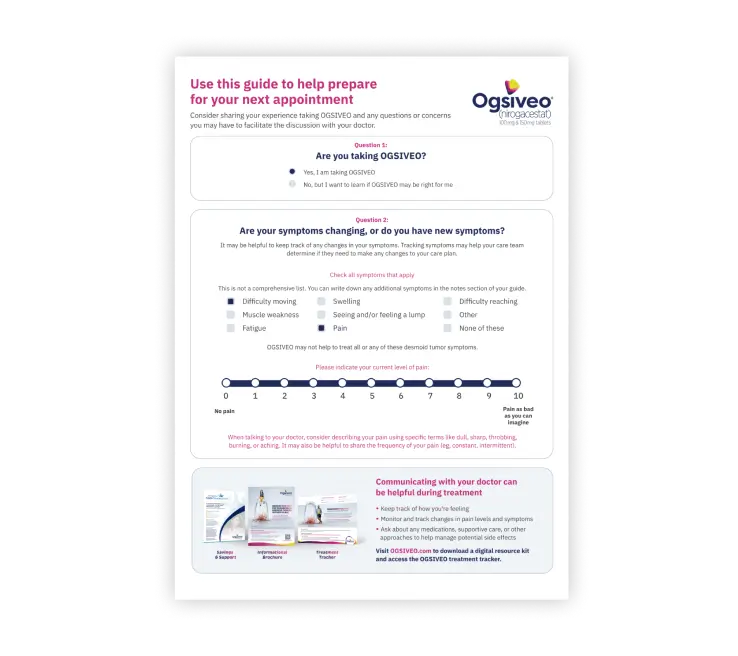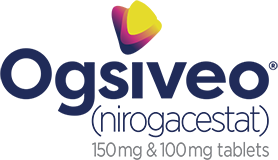Talk to your doctor to find out if OGSIVEO may be right for you. Your doctor can tell you how to take OGSIVEO and help you understand possible side effects you may experience while on treatment.
How to Take OGSIVEO

The recommended starting dosage of OGSIVEO is 150 mg taken 2 times a day1

OGSIVEO can be taken with or without food1

Swallow OGSIVEO tablets whole. Do not break, crush, or chew1
Avoid eating or drinking grapefruit products, Seville oranges, and starfruit during treatment with OGSIVEO.
OGSIVEO is convenient to take at home

Everyone responds to medication differently. If you think you may be experiencing side effects, talk to your doctor. Your doctor may change your dose, temporarily stop, or permanently stop treatment with OGSIVEO if you develop side effects.

Tablets shown are not actual size. See blister pack for opening and use instructions.
OGSIVEO blister packs may help you track your dose more easily with clear AM/PM dosing by day of the week
- Each blister pack contains a 7-day supply
- Four blister packs provide a 28-day supply
I wish the blister packs were available when I was on clinical trial to help make tracking my medication routine easier.– Dana, participant in Phase 2 clinical trial for OGSIVEO

Questions about taking OGSIVEO
How should I take OGSIVEO?
OGSIVEO is an oral medicine you can take with or without food.
- OGSIVEO comes in 100 mg and 150 mg tablets
- The recommended dosage of OGSIVEO is 150 mg taken 2 times a day
- Take OGSIVEO exactly as your healthcare provider tells you to take it
- Swallow OGSIVEO tablets whole. Do not break, crush, or chew
- If you take an antacid medicine, take OGSIVEO 2 hours before or 2 hours after taking the antacid
- Tell your doctor about all the medicines you take—including prescription and over-the-counter medicines, vitamins, and herbal supplements
What if I vomit or miss a dose?
If you vomit after taking a dose or miss a dose of OGSIVEO, take your next dose at the regular time. Do not take 2 doses of OGSIVEO to make up the dose.
What should I avoid when taking OGSIVEO?
Certain foods or medicines may cause a change in the way OGSIVEO acts in the body. Avoid eating or drinking grapefruit products, Seville oranges, and starfruit during treatment with OGSIVEO.
Proton pump inhibitors (PPIs), H2 blockers, and antacids are different types of medicines that affect stomach acid. They may be available over-the-counter or with a prescription.2-4
You should avoid taking proton pump inhibitors (PPIs) or H2 blockers during treatment with OGSIVEO.
- PPIs and H2 blockers reduce the amount of stomach acid made by the cells lining the stomach2,3
- PPIs and H2 blockers may be used for acid reflux or a stomach ulcer2,3
- Omeprazole (Prilosec®), lansoprazole (Prevacid®), and esomeprazole (Nexium®) are examples of PPIs2
- Cimetidine (Tagamet HB®), famotidine (Pepcid®), and nizatidine (Axid®) are examples of H2 blockers3
If you take an antacid medicine, OGSIVEO should be taken 2 hours before or 2 hours after taking the antacid.
- Antacids work by neutralizing stomach acid to help treat heartburn and indigestion4
- Tums®, Rolaids®, and Mylanta® are examples of antacids5
Ask your healthcare provider if you are not sure if you take one of these medicines.
How long will I take OGSIVEO?
Take OGSIVEO as long as your doctor tells you to stay on treatment. In general, you will keep taking OGSIVEO unless your tumor progresses (grows) or you have troublesome side effects that cannot be managed, as determined with your doctor.
During the clinical trial, people took OGSIVEO for a time period ranging from less than 1 month to over 2.5 years. Some people even continued or started taking OGSIVEO during the study extension period.
How do I store OGSIVEO?
- Store OGSIVEO tablets at room temperature between 68°F to 77°F (20°C to 25°C)
- Keep OGSIVEO and all medicines out of reach of children
Tell your doctor about all the medicines you take—including prescription and
over-the-counter medicines, vitamins, and herbal supplements1

Tips for taking medication
- Make it part of your daily routine. For example, take your medication before or after brushing your teeth6
- Set daily reminders on your phone. It might help make remembering to take your medication easier
- When traveling, bring enough of your medication plus a few days’ extra6
Track Your Symptoms with the OGSIVEO Treatment Tracker
Use this resource to monitor your symptoms, such as pain, during treatment with OGSIVEO.

Before taking OGSIVEO, tell your healthcare provider about all of your medical conditions, including if you:1
- Have liver problems
- Are pregnant or plan to become pregnant. OGSIVEO can harm your unborn baby. Tell your healthcare provider if you become pregnant or think you may be pregnant during treatment with OGSIVEO

Females who are able to become pregnant:
- Your healthcare provider will give you a pregnancy test before you start treatment with OGSIVEO
- You should use effective birth control (contraception) during treatment with OGSIVEO and for 1 week after the last dose. Talk to your healthcare provider about birth control methods that may be right for you
- Stop taking OGSIVEO and tell your healthcare provider right away if you become pregnant

Males with female partners who are able to become pregnant should use effective birth control (contraception) during treatment with OGSIVEO and for 1 week after the last dose.
- Are breastfeeding or plan to breastfeed. It is not known if OGSIVEO passes into your breast milk. Do not breastfeed during treatment with OGSIVEO and for 1 week after the last dose
Possible Side Effects
In the clinical trial, 95% of side effects were mild or moderate in intensity and
occurred within 1 month of starting treatment with OGSIVEO.7
If you think you may be experiencing any side effects, call your healthcare provider. Your healthcare provider may recommend medications or other approaches to help you manage side effects. Your healthcare provider may change your dose, temporarily stop, or permanently stop treatment with OGSIVEO.1
OGSIVEO can cause serious side effects, including:1
Diarrhea
Diarrhea is common during treatment with OGSIVEO, and may sometimes be severe. Your healthcare provider may tell you to drink more fluids, or may tell you to take antidiarrheal medicines. Tell your healthcare provider right away if you have diarrhea that lasts longer than a few days and does not get better after taking antidiarrheal medicines.
Ovarian Problems
Females who are able to become pregnant may have ovarian problems and changes in their menstrual cycle during treatment with OGSIVEO. OGSIVEO may affect fertility which may affect your ability to have a child. Tell your healthcare provider if you have any changes in your menstrual cycle or any hot flashes, night sweats, or vaginal dryness during treatment with OGSIVEO.
Liver problems
OGSIVEO can cause an increase in liver enzymes. Your healthcare provider will do blood tests to check your liver function before you start and during your treatment with OGSIVEO.
New non-melanoma skin cancers
Your healthcare provider will do skin exams before and during treatment with OGSIVEO if you are at risk for skin cancer. Tell your healthcare provider if you have any new or changing skin lesions.
Electrolyte (salt) problems
Your healthcare provider will do blood tests to check your phosphate and potassium levels during treatment with OGSIVEO and may give you medicines to treat low phosphate or low potassium if needed. Tell your healthcare provider if you develop any muscle pain or weakness.
The Most Common Side Effects of OGSIVEO are:1
- Rash
- Nausea
- Tiredness
- Mouth sores
- Headache
- Stomach (abdominal) pain
- Cough
- Hair loss
- Upper respiratory infection
- Shortness of breath
These are not all of the possible side effects of OGSIVEO. Call your doctor for medical advice about side effects. You are encouraged to report negative side effects or quality complaints of prescription drugs to the FDA. Visit www.fda.gov/medwatch or call 1-800-FDA-1088.
OGSIVEO can affect fertility in females and males, which may affect your ability to have a child. Talk to your healthcare provider if this is a concern for you.1
If you think you may be experiencing any side effects, call your healthcare provider. Your healthcare provider may recommend medications or other approaches to help you manage side effects. Your healthcare provider may change your dose, temporarily stop, or permanently stop treatment with OGSIVEO.1
Hear from Dana, a patient who participated in a Phase 2 clinical trial for OGSIVEO
Dana experienced side effects while taking OGSIVEO. Hear about how she worked with her doctor to manage them.
This video represents Dana’s personal experience only. Individual results may vary.
Questions about OGSIVEO side effects
What should I do if I think I am having side effects?
Side effects can start within the first month of taking OGSIVEO.7 There might be therapies or other approaches that your doctor or care team can recommend for certain side effects to help during treatment. Let them know what you experience. Your doctor may recommend pausing treatment until side effects subside. Your doctor may also determine if a lower dose or stopping treatment is right for you. Always follow your doctor’s recommendations.
Will OGSIVEO affect my menstrual cycle?
Females who are able to become pregnant may have ovarian problems and changes in their menstrual cycle (including irregular periods or no periods) during treatment with OGSIVEO. Symptoms such as hot flashes, night sweats, or vaginal dryness are common in females of reproductive potential treated with OGSIVEO.1 Talk to your doctor if you have any questions about what to expect during treatment with OGSIVEO.
Can diarrhea be managed while taking OGSIVEO?
Diarrhea is a common side effect of OGSIVEO and may sometimes be severe. Your doctor may recommend an over-the-counter anti-diarrheal medication or other strategies to manage it. Loperamide is an example of an anti-diarrheal medication. Let your doctor know right away if you have diarrhea that lasts longer than a few days and does not get better after taking antidiarrheal medicines.1
Staying hydrated can help. Drink plenty of fluids throughout the day. You may also find it easier to eat smaller meals more often instead of large ones. Consider choosing bland foods and avoiding foods that may cause stomach upset, such as caffeine, alcohol, dairy, and spicy, fatty, or greasy foods.8,9
Keeping track of your bowel movements can be helpful for your doctor. This includes how often you go, the consistency of your stools, and any discomfort you experience.8,9
Create a Customized Doctor Discussion Guide
A guide you can bring along to your next appointment to help facilitate the discussion with your doctor.


